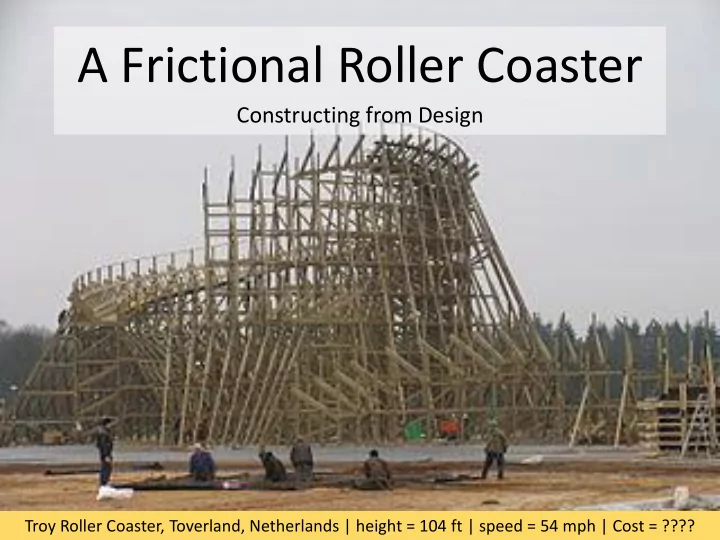

A Frictional Roller Coaster Constructing from Design Troy Roller Coaster, Toverland, Netherlands | height = 104 ft | speed = 54 mph | Cost = ????
Do you have any idea of the cost of roller coaster projects?
El Toro Six Flags Great Adventure, Jackson, NJ Height: 181 ft Speed: 70 mph Length: 4,400 ft Guess the cost…
Thunder Dolphin Tokyo Dome City Attractions, Tokyo, Japan Height: 260 ft Guess Speed: 81 mph the cost… Length: 3,497 ft
Millennium Force Cedar Point Park, Sandusky, OH Height: 310 ft Speed: 93 mph Length: 6,995 ft Guess the cost…
Roller coasters are expensive and complex projects… Have you ever worked a school roller coaster project? Steel Dragon 2000, Mie Prefecture, Japan | Height = 318 ft | Speed = 95 mph | Cost = $52M
Are you ready for a school roller coaster project? …and to have a lot of fun?
Your Engineering Challenge Project requirements and constraints: • Work as real-world professional engineers do — from design to final product • Use the physics you learned in the previous lesson, A Tale of Friction • Define your roller coaster’s path as a differentiable function • Do the necessary calculations to prove that your coaster is going to work , before building it Are you ready for all this fun?
Project Guidelines • Work in teams of 3 or 4 members • Design your coaster’s path using at least 5 differentiable functions; to simplify the calculations, use parabolas • The piecewise function produced must be differentiable
Project Guidelines Your design dimensions must be appropriate to the flexibility of • the material you use to build the model: foam pipe insulation 1.5-in external diameter pipe insulation material is suggested • • That means, no very sharp curves or loops • Mount the roller coaster on a big enough flat surface; a 3 x 4-ft cardboard sheet is recommended
Project Guidelines • Use this formula 2 − 2 ∙ (𝑔 𝑦 𝑔 − 𝑔 𝑦 𝑗 ) − 4 𝑤 𝑔 = 𝑤 𝑗 7 ∙ ∙ 𝑔 𝑦 𝑔 − 𝑔(𝑦 𝑗 ) to determine the maximum height the marble will reach after rolling from a high point on the upward-opening parabolas (The velocity of the marble at this maximum height is zero)
Project Guidelines • Use the height the marble reaches at the end of an upward-opening parabola to determine the height of the vertex for the next downward- opening parabola • At path beginning, the initial marble velocity must be zero • At path end, the final velocity must also be zero (or almost)
Project Guidelines • Use Excel to make the required computations and produce a graph of the designed path • Use the velocity formula to test the functionality of the entire designed path; the velocity must be greater than zero at every point on the path, except at the ends
Project Guidelines • Find the piecewise function for the designed path 2 1 284 ( x 20 ) 0 x 16 9 2 13 284 400 13 ( x 38 ) x 116 9 9 2 1 400 456 ( x 56 ) x 16 9 7 f ( x ) 2 456 534 2 8 ( x 70 ) x 17 7 7 2 534 1 ( x 84 ) x 90 16 7 2 5 5 ( x 96 ) 90 x 96 64 • Use points from this function to build your model
Project Guidelines • Test your model. Then make conclusions about your design and your model: • Is it behaving as expected? If not, why? • What were the failures? • What problems did you have during construction? • How did you solve them? • Make a class presentation of your model, design process, computations, construction process, and conclusions • Support your presentation with a slide show or video. • A standalone presentation earns extra points. • See details in rubric handout
Have fun with this real-world engineering challenge project!
Recommend
More recommend